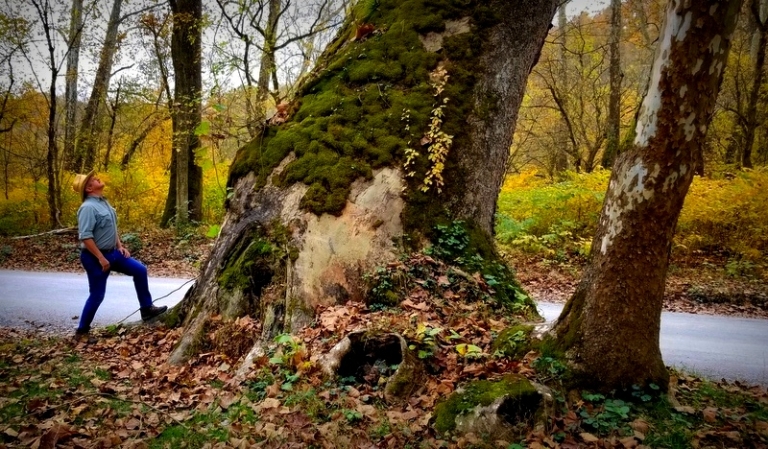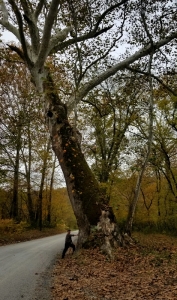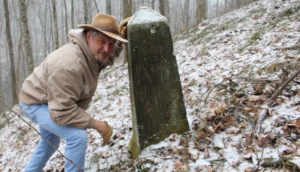
When George Washington first visited Point Pleasant in present-day West Virginia in 1770 he discovered a sycamore that measured 44 feet and 10 inches around—or roughly 14 feet across. That's not quite the size of a 2021 Cadillac Escalade, but it's close.
You won't find trees that size in West Virginia anymore, though you can still find some whoppers, and the largest tree in West Virginia, also a sycamore, isn't that hard to find. In the valley of Wheeling Creek it stands, or leans, as the case may be, about 12 miles as the crow flies from the mouth of the creek on the Ohio River.

Depending upon how you drive, there being no direct route, it's a journey of about 20 miles or 45 minutes from Wheeling, West Virginia, and only about two air-miles from the Pennsylvania line.
Recorded by the W.Va. Division of Forestry in 1963, it's almost 26 feet in circumference or eight-and-a-quarter feet in diameter and stands more than 117 feet tall with a 128-foot crown.
Other notable trees in West Virginia have included the Webster Sycamore, formerly located near Webster Springs in Webster County. It attained a 25.75-foot circumference, a height of 112 feet, and a 90-foot crown. A vandal's fire injured the mighty tree in 2007 and it succumbed and was felled in 2010.
Another prize-winner, the Mingo Oak, in Mingo County, was reported to have been the world's largest white oak. It stood 145 feet tall, grew to more than 25 feet in circumference, and its limbs spread 96 feet. It succumbed to the fumes of a burning coal refuse pile and was cut down in 1938—felled by two Webster County loggers. At the time its age was calculated to be 577 years old.
Of all West Virginia trees, sycamores generally grow largest and, in fact, often provided shelter for pioneers and early settlers—a circumstance facilitated by their tendency to hollow as they age. Many sycamores develop a cavity large enough to admit a person, and some of the oldest grew large enough to admit a person or two. The Pringle Brothers lived in a hollow sycamore near what's now Buckhannon in the 1760s, and Stephen Sewell was living in a hollow sycamore in present-day Marlinton in 1751.
If you have the chance to visit the Wheeling Creek Sycamore, you probably won't find it difficult to consider the age of the tree. According to some calculations, it first lifted its crown above the valley floor some 400 years ago—more than 150 years before Washington floated down the Ohio River to find the enormous sycamore at Point Pleasant.
"The mammoth tree has witness centuries of travelers and fishermen passing by," says Jesse Mestrovic, the director of parks and recreation for the City of Wheeling.
Mestrovic regularly kayaks Wheeling Creek and says the tree is a point of reference for kayakers who sometimes put-in just upstream near the Dunkard Fork Wildlife Management Area. During high water, usually in spring, the creek may be paddled from there to its mouth in Wheeling.
Mestrovic says kayak rentals and shuttles are now offered by South Paw Outfitters in Elm Grove, and the W.Va. Division of Natural Resources stocks trout in the headwaters of Wheeling Creek in February and May.
The sycamore is located along Marshall County Route 1511, a well-graveled road that follows the creek approximately 3.3 miles upstream from Viola, West Virginia, which may be the best point of reference to use for visitors using an online mapping service to plot their course.
For more information on the tree or about visiting Ohio County, contact the Wheeling Convention and Visitors Bureau.
Storied West Virginia monument stands forgotten in woods

On a wooded hillside at the southwest corner of Pennsylvania stands a weathered monument that establishes West Virginia’s singular northern panhandle. Some say every panhandle resident should visit it, though it's hard to find. It’s also the western end of the Mason-Dixon Line and the southern end of the lesser-known “Ellicott Line,” the western boundary of Pennsylvania. Read the full story here.
Sign up to receive of FREE copy of West Virginia Explorer Magazine in your email weekly. Sign me up!




























